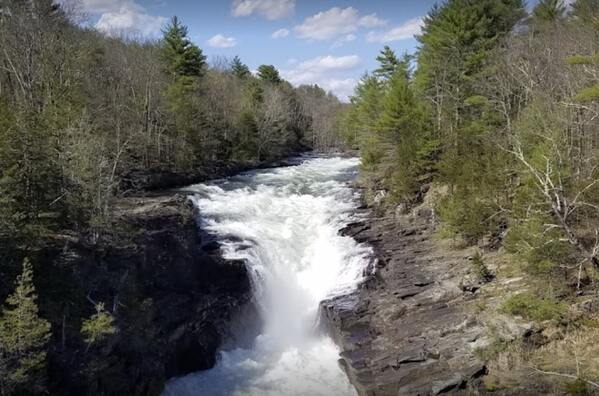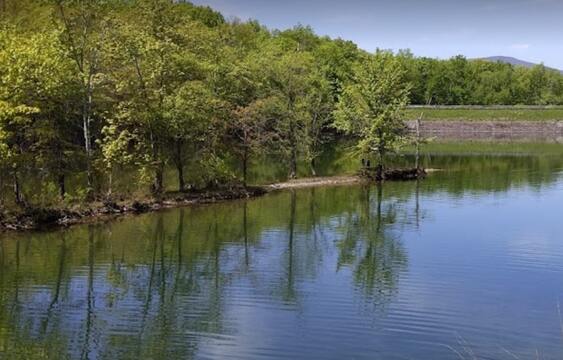
According to the official website of New York, their water supply consists of 19 reservoirs, which are natural or artificial lakes that are used as a source of water supply. This system is responsible for delivering just over 1 billon gallons of water (That’s with a “B”) to the New York City area every single day. One of these reservoirs is the Ashokan reservoir which has been used as a water supply and a fishing ground.
This article will go through everything you need to know about the Ashokan reservoir, including its history, building, and features.
What is the Ashokan Reservoir?
The Ashokan reservoir is a man-made water supply in the Ulster County of New York. It is one of only two reservoirs in the Catskill Water Supply System, the other being the Schoharie reservoir. The Ashokan goes deeper, almost 190 feet deep, and holds almost 123 billion gallons at total capacity.
The 8,315-acre reservoir was built in 1915 after dams were constructed five and a half miles within the Esopus Creek Drainage. The reservoir comprises two basins, the upper west and lower east, connected by a dividing weir in the center, eventually draining into the Hudson River.
Ashokan contributes 40% of New York City’s domestic water needs during its non-drought period.

The History of the Ashokan Reservoir
By the later 18th century, industrialization had contaminated most of what water was left in rivers and wells. It was then decided that New York City needed a new water source. However, no serious actions were truly taken until the late 19th and early 20th centuries.
In 1905, the State Legislature created the New York City Board of Water Supply, allowing them to acquire lands to build water reservoirs and dams.
Construction on the Ashokan Reservoir, natively called the “place of fish,” soon began in 1907. The area was mainly inhabited by farmers who had to relocate to the reservoir. By the time the reservoir opened, more than two thousand people had been forced from their homes, and hundreds of houses and buildings were either relocated or demolished.
According to Bob Steuding, professor at Ulster County Community College, the area around the Wes Basin alone consisted of more than five hundred houses, ten churches, ten schools, and many other buildings.
Many residents rioted against the dam’s construction, and most workers ended u fighting within themselves. Due to the increasing violence and disturbance, a police force was created to keep the peace around the reservoir. The police force later became the New York City Department of Environmental Protection.
The construction of the reservoir was completed in 2015, and the reservoir was officially functioning, with a hundred miles of underground piping built to reach New York City.
Physical Features and Location
The reservoir covers a surface area of 8300 acres and a shore length of 40 miles. The maximum depth of the reservoir is 190 ft, towards the Hudson river, while the average depth is around 4 feet.
The Ashokan reservoirs can hold 465 million cubic meters of water at total capacity.
It is located about 70 miles north of New York City and 13 miles west of Kingston. The important landmarks around the reservoir include the Fruition Chocolate Works and hotel Dylan. You can get to the reservoir by taking route 28 or 28A. For a better idea, you can check the map for the Ashokan Reservoir here.
Activities in the Ashokan Reservoir
For safety reasons, the reservoir does not offer many activities. For example, swimming is strictly prohibited in the reservoir to ensure that the water remains clean. It is also illegal to ride a Motorcraft that uses gasoline.
Some activities that you can do in the Ashokan Reservoir are mentioned below.
Boating
You will require a public access permit if you fish to go boating in the Ashokan reservoir. You will also have to disclose the purpose of going boating and will have to follow strict rules.
Fishing
The word Ashokan means a place of fish, a native name given to the area for the different species of fish found in the reservoir. The various fish species include Rainbow Trout, Brown Trout, Yellow Bullhead, Brown Bullhead, White Sucker, Common Carp, Bluegill, Black Crappie, Rock bass, Largemouth Bass, Smallmouth Bass, Redbreast Sunfish, Alewife, Walleye, Yellow Perch, and White Perch.
Fishing in the Ashokan reservoir requires a public access permit. In the spring. The reservoir is filled with more than 16,000 brown trout, who use the upper Esopus Creek as their breeding area. Brown Trot of around ten pounds is usually caught, with an occasional 15-pound trout being caught.
Besides the brown trout, the most commonly seen warm water fish species in the reservoir are the White Perch and the Smallmouth Bass. They are primarily caught using a casting minnow during the spring.
Rarely, a Walleye and Largemouth Bass has also been reported in the Ashokan Reservoir, but they are not easily caught. In 2015, DEC fisheries caught a 32-inch walleye weighing around 17 pounds.
Ashokan Trail
The Ashokan trail is open year-round and consists of an 11.5-mile course running along the reservoir between Bioceville and West Hurley. The track can be started from three trailheads, the Woodstock Dike Trailhead near West Harley at 1285 NY-28, the Ashokan Station Trailhead in Shokan at 3045 NY-28, and the Boiceville Bridge Trailhead in Bioceville at 5080 Route 28A.
However, there are specific rules you must keep in mind. These rules include:
- Keep to the right on the trail
- Park only in the designated parking area
- Take all garbage with you when you exit.
- Do Not Trespass
To Conclude
The Ashokan Reservoir has a deep history and serves as more than just a clean water supply for New York. The many recreational activities give the reservoir even greater importance as a natural landmark. Be it fishing, trailing, boating, hiking, or more, visit the Ashokan reservoir to start an adventure you will not forget.
